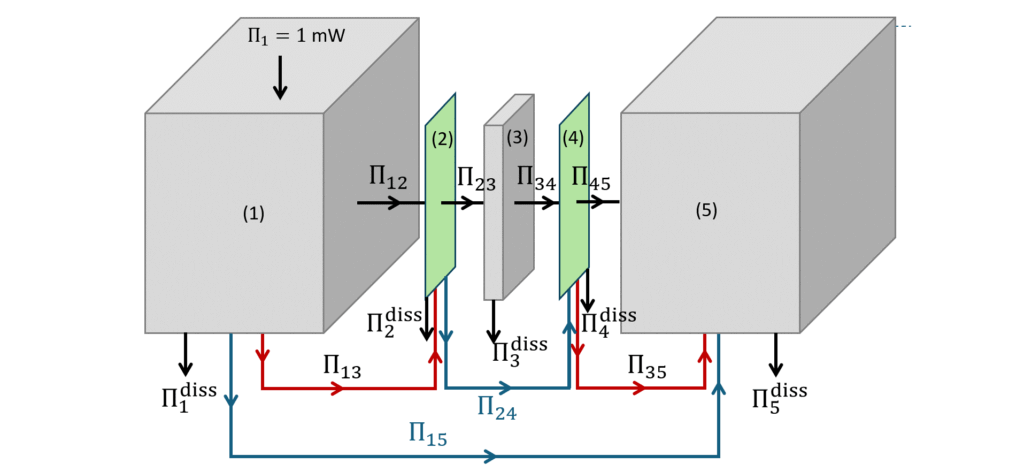The paper from Price and Crocker1 more than fifty years ago initiated a still ongoing discussion about modelling double panel sound transmission using statistical energy analysis. This sometimes confusing discussion results from the fact, that the double wall case establishes a very critical case for SEA for several reasons that will be elaborated here in detail. This is done using the pyva toolbox applied to the examples from Price’s original paper.
A step by step description summarizes the modelling of the examples from the original paper revealing the power of SEA modelling of double walls but also showing the limits of SEA when the basic prerequisites are not met. Each single figure and example case is shown as pyva implementation comparing the results from the original paper. The full python code of the Price example can be downloaded from the example section of the pyva documentation.
Library initialization and model setup
In the paper several double wall configurations are modeled using SEA. The theory is implemented here and the major steps of this modelling are shown. If you are interested in following the examples please refer to the pyva documentation where the full example can be downloaded.
Module import
Each pyva simulation script starts with the import of the related modules
# pyva main model module
import pyva.models as mds
# Coupling module
import pyva.coupling.junctions as con # junctions module
# Property modules
import pyva.properties.structuralPropertyClasses as stPC
import pyva.properties.materialClasses as matC
# Layer module for transfermatrix methods
import pyva.systems.infiniteLayers as iL
# SEA system modules
import pyva.systems.structure2Dsystems as st2Dsys # plate systems module
import pyva.systems.acoustic3Dsystems as ac3Dsys # cavity systems moduke
import pyva.loads.loadCase as lC # loadcase module
# Modules for system matrices and degree of freedom
import pyva.data.dof as dof
import pyva.data.matrixClasses as mC
# Pyva utilities
import pyva.useful as uf
Initialization of geometry
Frequency range and geometry are initialized using python variables. The double wall cavity is well specified in the paper but the properties of the main cavities are not given in detail. For simple transmission loss calculations both cavities (1) and (5) are chosen as large cavities to fulfill the random conditions and the absorption surface ![]() in the receiving cavity is set equal to the junction area
in the receiving cavity is set equal to the junction area ![]() . This simplifies the transmission loss calculation because in
. This simplifies the transmission loss calculation because in
TL = L_p^{(1)}-L_p^{(5)} -10 \log_{10}\frac{S_j}{A_s}\overset{S_j=A_s}{=}L_p^{(1)}-L_p^{(5)} \hspace{3cm} (1)and with ![]() the transmission loss becomes simply the difference of the pressure levels.
the transmission loss becomes simply the difference of the pressure levels.
#%% Frequency range
omega = mC.DataAxis.octave_band(f_min=2*np.pi*100,f_max=2*np.pi*10000,bands_per_octave = 3)
# Create according ndarrays for plotting
om = omega.data
freq = om/2/np.pi
# Panel dimensions
L1 = 1.55 # panel/DW cavity width
L2 = 0.071 # DW cavity thickness
L3 = 1.97 # panel/DW cavity height
L1_fig3 = 2.2 # height of cavity from fig 3
S = L1*L3 # panel surface
S_dwc_edge = L2*2*(L1+L3)# DW cavity edge surface
# Cavity volumes
V_dwc = L1*L2*L3 # Volume DW cavity
V1 = 100 # room 1
V2 = 100 # room 2
# Absorption areas in large cavities
As1 = 2. # arbitrary room absorption area
As2 = S # secong room absorption area equal to junction area for log10(S/As2)=0
Material and Properties
The Fluid and IsoMat Classes of the materialClasses module are used to model the materials. All plates are aluminum panels of various thicknesses. Their thickness is specified using the PlateProp of the structuralProperty module.
# Materials
alu = matC.IsoMat(eta=0) # Alu is the default isomaterial
air = matC.Fluid(eta=0) # Air is the default fluid
# Plate properties
alu_3_18mm = stPC.PlateProp(0.00318,alu) # 0.85 g/cm^2
alu_6_36mm = stPC.PlateProp(0.00636,alu) # 1.71 g/cm^2
alu_0_88mm = stPC.PlateProp(0.00088,alu) # 0.24 g/cm^2
alu_9_26mm = stPC.PlateProp(0.00925,alu) # 2.5 g/cm^2
Subsystem definition
There are two type of subsystems involved. Flat rectangular plates and fluid cavities. All SEA system classes are located in the systems package. This package provides classes and methods to deal with the properties of SEA subsystems and the conversion of energy results into engineering units. Each subsystem is identified by an integer ID as first argument. The chosen IDs follow the numbering convention of the paper.
Cavities
Cavities are created using Acoustic3DSystem module. The large sending and receiving rooms are supposed to be artificial cavities with volume but without surface and perimeter. This means that only the volume is used for the modal density determination in Equation (3).
# Cavity subsystems
room1 = ac3Dsys.Acoustic3DSystem(1, V1, 0, 0, air, absorption_area = As1, damping_type= ['surface'])
room2 = ac3Dsys.Acoustic3DSystem(5, V2, 0, 0, air, absorption_area = As2, damping_type= ['surface'])
The double wall cavity is rectangular. Therefore, the RectangularRoom class is used that implements methods (and assumptions) specifically true for this kind of cavity. Price assumed that the radiation efficiency doubles below the coincidence frequency because of the flat cavity. This is now implemented in pyva for this paper reflection, the flat_cavity_sw triggers this doubled radiation efficiency.
# Double wall cavity
dwc = ac3Dsys.RectangularRoom(3, L1, L2, L3, air, eta = eta_DWC,flat_cavity_sw = True)
Damping loss factor of double wall cavity
In the RectangularRoom constructor the damping is specified by the eta = eta_DWC argment. This argument can be a constant float value but also a Signal, here a spectrum that specifies a frequency-dependent damping according to the paper. From 100-2000 Hz the damping loss is taken from table B-I of the paper. Above 2000 Hz equation (B11) is used with ![]() .
.
#Tables for DW cavity damping
omega_min = 2*np.pi*100 # in all arguments pyva uses angular frequency
omega_max = 2*np.pi*10000
freq_tab_BI = mC.DataAxis.octave_band(omega_min,omega_max,typeID = 21)
# Create table until 10000Hz
eta_DWC_data = np.zeros(np.shape(freq_tab_BI))
# Fill data until 2000 Hz
eta_DWC_data[0,:14] = 0.01*np.array([[3.18, 2.29, 2.38, 2.89, 2.68,
2.72, 2.79, 3.27, 3.09, 2.80,
2.38, 2.00, 1.60, 1.27 ]])
# Fill data from 3200 - 10000 Hz with equation B11
def B11(omega):
return air.c0*S_dwc_edge/6/omega/V_dwc # alpha = 1
eta_DWC_data[0,14:] = B11(freq_tab_BI.data[14:])
# Signal object with scalar degree of freedom and unit-less type
eta_DWC = mC.Signal(freq_tab_BI, eta_DWC_data, dof.DOF(0,0,dof.DOFtype(typeID = 1)))
The python coded creates the damping spectrum as shown in the following figure:
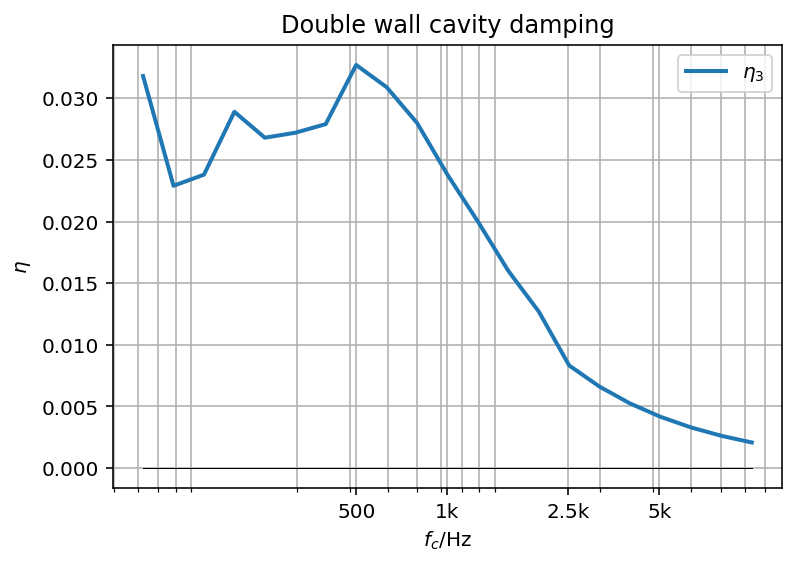
Plates
Plate subsystems are created using the RectangularPlate class from the structural2Dsystem module. The convention is that all plates are named in relation to the figure in Price paper the results are presented, here figure 5.
# Plate subsystems
plate1_fig_5 = st2Dsys.RectangularPlate(2, L1,L3,prop=alu_3_18mm, eta = 0.005)
plate2_fig_5 = st2Dsys.RectangularPlate(4, L1,L3,prop=alu_3_18mm, eta = 0.005)
Double wall frequencies
It is surprising that the double wall frequency that separates the single wall from the double wall dynamics is not considered at all by Price. For further discussions the double wall frequency is calculated with:
f_{DW}=\frac{1}{2\pi}\sqrt{\frac{\rho_0c_0^2}{L_2\mu}} \text{ with } \mu'' = \frac{m''_1m''_2}{m''_1+m''_2} \hspace{3cm} (2)Here ![]() ,
, ![]() and
and ![]() are the effective mass per area, the first panel mass per area and the second panel mass per area, respectively. The resulting frequencies are as follows:
are the effective mass per area, the first panel mass per area and the second panel mass per area, respectively. The resulting frequencies are as follows:
Double wall resonance Fig.5: 109.7Hz
Double wall resonance Fig.6: 95.0Hz
Double wall resonance Fig.7: 166.6Hz
Modal density and modes in band
Every SEA simulation starts with investigating the statistical quantities of the involved subsystems. In the paper the modal density is calculated using the formula for 2D cavities (Eq.(28)) and 3D cavities (Eq. (29)). Both regimes are separated by the cross-mode frequency ![]() . In Figure 3 the results from the classical Maa2 formula and the paper results are compared to the numerical result counting the modes in the double wall cavity.
. In Figure 3 the results from the classical Maa2 formula and the paper results are compared to the numerical result counting the modes in the double wall cavity.
The Maa formula used in many commercial SEA software and also pyva is given by:
n(\omega)=\frac{V\omega^2}{2\pi^2c_0^3}+\frac{S\omega}{8\pi c_0^2}+\frac{P}{16\pi c_0} \hspace{3cm} (3)With the volume ![]() , the surface
, the surface ![]() and the perimeter
and the perimeter ![]() .
.
The formula from Price performs best, the thin cavity establishes a clear distinction between the two- and three dimensional case. Note that the dimensions of Fig.3 are not the same as for the double wall cavity of all other calculations.
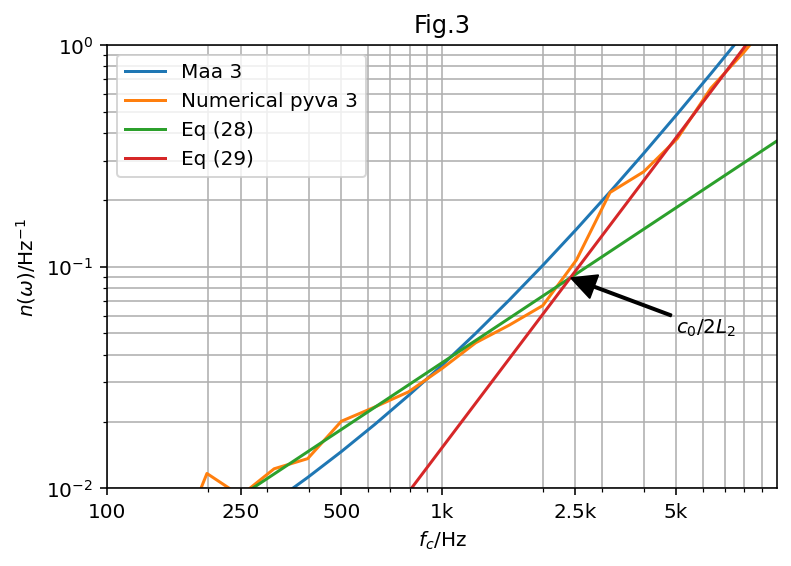
However, the modal density below 500 is very low. Too low for this even larger cavity to be considered as random system. When the number of modes counted per octave band is calculated it can be seen that a reasonable number of modes is reached starting from the 500Hz third octave. Thus, the double wall cavity cannot be considered as random subsystem below 500 Hz.
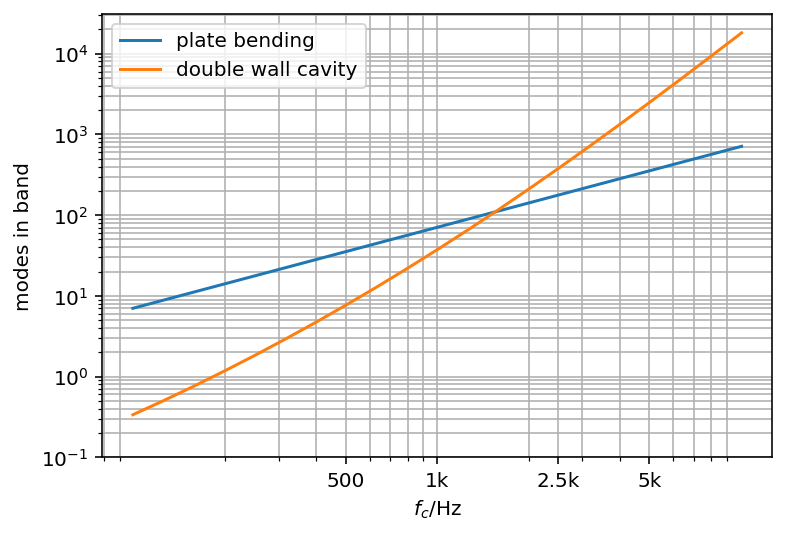
SEA model creation
Each model requires a defined analysis frequency range. The DataAxis class of the matricClasses does this job.
omega = mC.DataAxis.octave_band(f_min=2*np.pi*100,f_max=2*np.pi*10000,bands_per_octave = 3)
The SEA model is defined using the HybridModel class. This class combines FEM and SEA system descriptions. In the double panel model only the SEA part is used.
SEA_model = mds.HybridModel((room1,plate1_fig_5,dwc,plate2_fig_5,room2),xdata=omega)
The connection of the subsystem is defined by junctions, here shown for the example of Fig.5
#%% Junctions Fig 5 Model
J123_fig_5 = con.AreaJunction((room1,plate1_fig_5,dwc))
J345_fig_5 = con.AreaJunction((dwc,plate2_fig_5,room2))
Those junctions must be added to the SEA model:
SEA_model.add_junction({'areaJ_123':J123_fig_5})
SEA_model.add_junction({'areaJ_345':J345_fig_5})
The model is now complete, except the sound source in room1
# Source in cavity 1
power1mWatt = lC.Load(omega, 0.001*np.ones(omega.shape),
dof.DOF(1,0,dof.DOFtype(typestr = 'power')), name = '1mWatt')
SEA_model.add_load('1mWatt',power1mWatt)
Solving the model
The remaining job is to setup the SEA matrix and solve the model:
SEA_model.create_SEA_matrix(sym = 1)
SEA_model.solve()
Pyva automatically calculates the engineering units from the energy results. Requesting the results gives:
SEA_model.result
Out[8]:
Signal object of 21 samples with 7 channels and properties ...
DataAxis of 21 samples and type angular frequency in 1 / second
DOF object with ID [1 2 2 3 4 4 5], DOF [0 3 5 0 3 5 0] of type
[DOFtype(typestr='pressure'),
DOFtype(typestr='velocity'), DOFtype(typestr='velocity'),
DOFtype(typestr='pressure'),
DOFtype(typestr='velocity'), DOFtype(typestr='velocity'),
DOFtype(typestr='pressure')]
All results are presented as Signals. This includes the IDs, the degrees of freedom DOF and the type of results (Here pressure and velocity). Note that in pyva plates have two wave DOFs for bending waves (DOF=3) and in-plane waves (DOF=5).
The missing step is to calculate the transmission coefficient keeping in mind that the difference of the pressure levels corresponds to the ratio of the squared pressure. The room pressure results are the signals with index 0 and 6.
p1 = SEA_model.result[0].ydata.flatten()
p2 = SEA_model.result[6].ydata.flatten()
tau = (p2/p1)**2
With this global procedure all examples from Price paper are recalculated.
Recalculated examples from Prices’ paper
Two aluminum plates of 3.18mm thickness
The symmetric case of figure 5 is the first case in the paper. Figure 5 reveals that the pyva results are much higher below coincidence compared to the surprisingly well coinciding test and SEA results from the original paper. The double wall resonance is not visible in the test results. The curve doesn’t show the typical double panel behavior as it is for example described by Fahy3
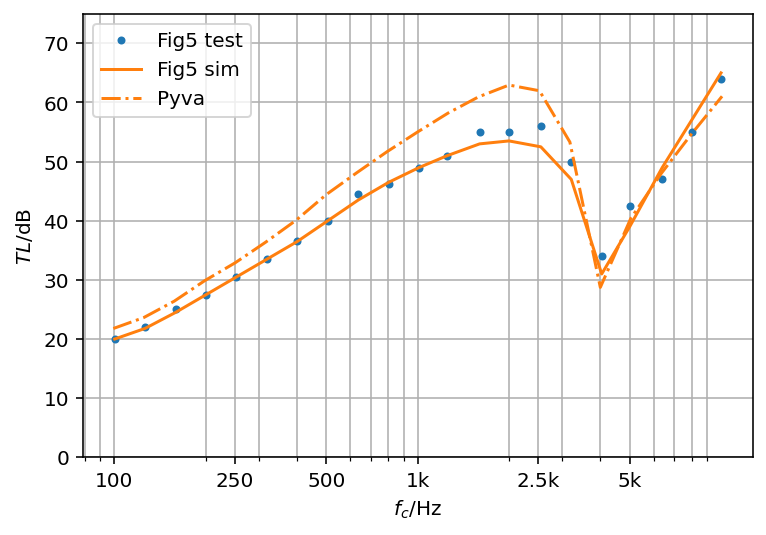
The reason for this discrepancy to current SEA implementations (and double wall theory) is hidden in the radiation efficiency or the radiation resistance as used by Price. The authors solve the SEA equations for bending wave excitation into plate 1. In equation (38) of the paper this provides the radiation resistance of the plate from test results exciting the plate at several locations. Because of this procedure every side paths that are not considered in the model are taken into account automatically and the SEA model result is adapted to the test results accidentally including the strong coupling, structure borne coupling and even additional paths.
This can be seen when the radiation efficiency from pyva based on the Leppington4 method is compared to Figure 9 of the paper. The so called clamped result agrees well with the test result (that may include many paths). The pyva result is 10dB lower than the test curve. Form the authors experience from numerical studies on rectangular plate radiation and tests the radiation efficiency below coincidence is less than in the paper. However, note that at the end of the sixties the computational power to solve such problem was not available.
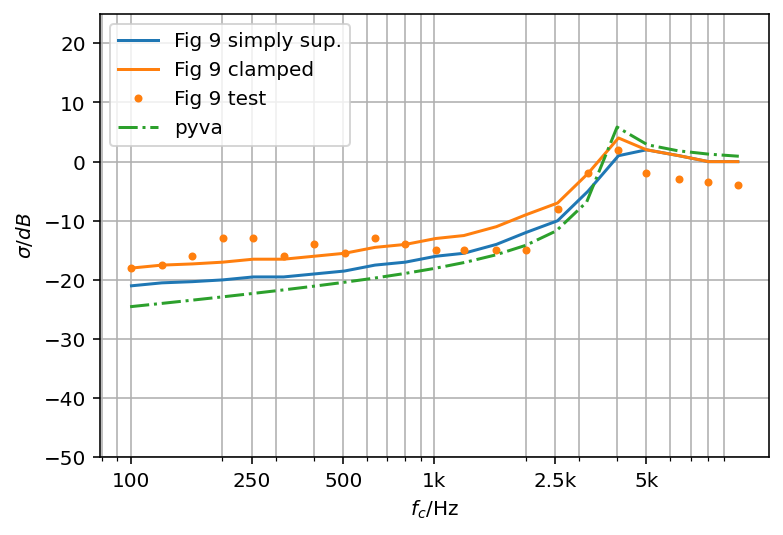
This high radiation efficiency may be the reason why the damping influence is too strong especially below coincidence. In Fig. 8 the high 5% damping loss has low impact below coincidence in the pyva results whereas the paper denotes a broadband shift that is too strong and is not in line with numerical and test results of a single plate.
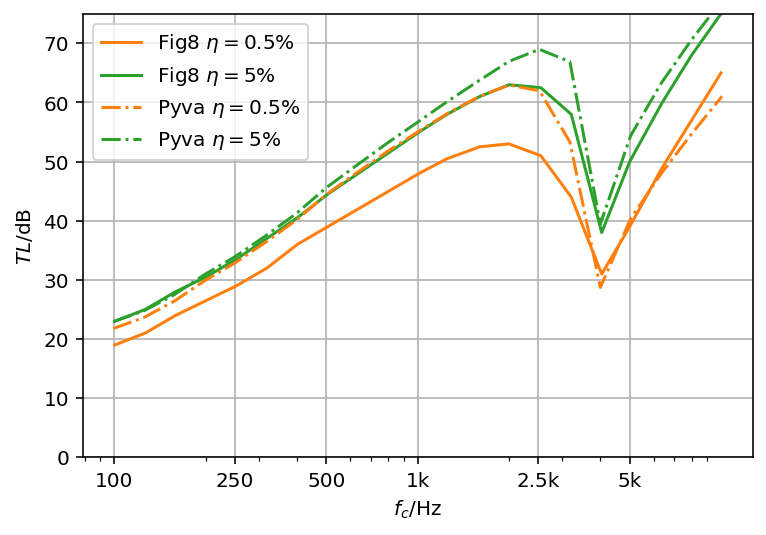
Please note, that at and above coincidence when all SEA assumptions are fulfilled, Prices’ and pyva curves agree very well with the test results.
Two different aluminum plates of 6.36 mm and 3.18 mm thickness
The second example is a non-symmetric configuration with one plate doubled in thickness. The results from pyva and from Figure 6 in the paper show the distinct coincidence frequencies. Paper and pyva results agree well above the second coincidence but below coincidence the transmission loss is also underestimated. However, the pyva result agrees better to the tests above the first coincidence of the thicker 6.38mm plate at ![]() Hz.
Hz.
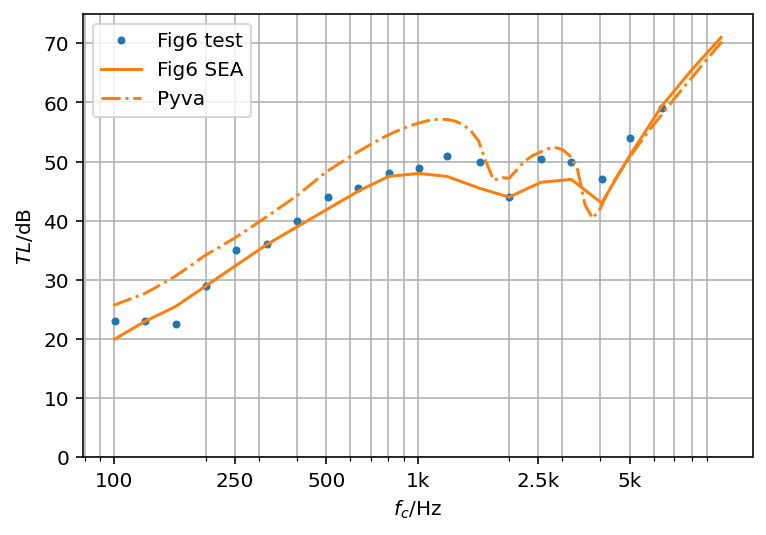
Two thin 0.88mm panels without coincidence
An interesting case is created with two aluminum panels of 0.88mm thickness. The coincidence of such panels is at ![]() Hz and therefore above highest simulation and test frequency. The double wall resonance is at
Hz and therefore above highest simulation and test frequency. The double wall resonance is at ![]() Hz. With this configuration the radiation efficiency of both panels is very low and the mass law dominates. Thus, the agreement between the original paper, pyva and the tests is quite good above 500 Hz when the SEA assumptions are fulfilled. A slight double wall dip may be noticed in the test data.
Hz. With this configuration the radiation efficiency of both panels is very low and the mass law dominates. Thus, the agreement between the original paper, pyva and the tests is quite good above 500 Hz when the SEA assumptions are fulfilled. A slight double wall dip may be noticed in the test data.
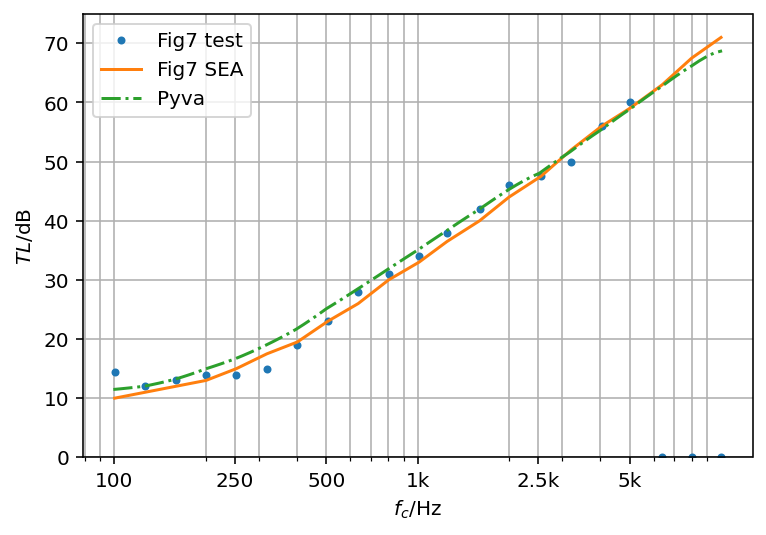
Variation of double wall thickness
A theoretical study is shown in Figure 10 with varying thicknesses of the double wall. The considered values of ![]() are 1cm, 10cm and 20cm. Especially for the first value the double wall resonance frequency must not be neglected. The frequencies are:
are 1cm, 10cm and 20cm. Especially for the first value the double wall resonance frequency must not be neglected. The frequencies are:
Double wall frequency for L2=1cm : 292.2Hz
Double wall frequency for L2=20cm : 65.3Hz
Double wall frequency for L2=40cm : 46.2HzThe coincidence frequency of this 9.26mm thick panels is ![]() and efficient radiation is shifted to low frequencies for this thick plate. The results of pyva have a similar slope than in the paper (not presented here). The dependence from the double wall cavity thickness is much higher for pyva than the original curves. How the damping of the cavity is modified due to thickness is not mentioned in the paper. As edge surface and volume depend linearly on
and efficient radiation is shifted to low frequencies for this thick plate. The results of pyva have a similar slope than in the paper (not presented here). The dependence from the double wall cavity thickness is much higher for pyva than the original curves. How the damping of the cavity is modified due to thickness is not mentioned in the paper. As edge surface and volume depend linearly on ![]() in equation (B1) the damping is assumed constant with varying thickness.
in equation (B1) the damping is assumed constant with varying thickness.
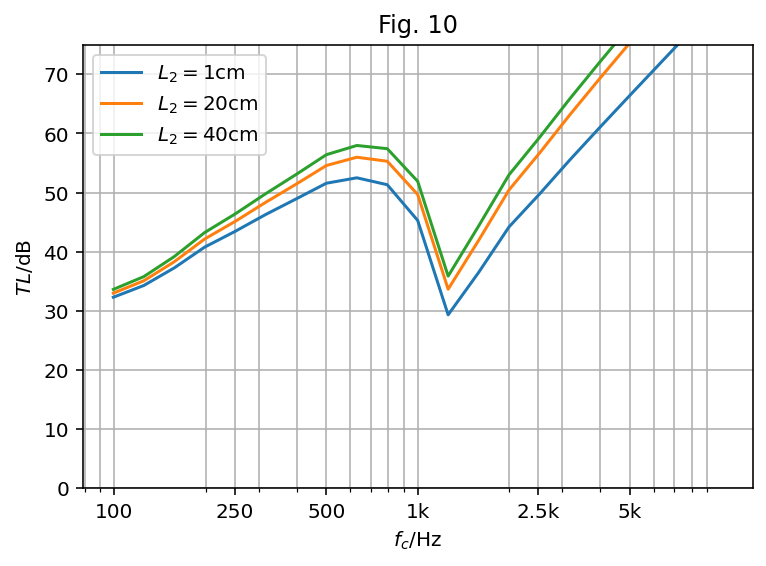
Conclusions
The paper from Price and Crocker presents the first SEA model of double panel sound transmission. The details of the subsystem descriptions, the coupling loss factors and the damping loss of the inner cavity are worked out in detail. However, the random nature of the double wall cavity or the panel-cavity-panel system is never questioned. Thus, the tricky issue with double walls in the context of SEA; the strong coupling especially at the double wall resonance is not dealt with.
Usually it is a good practice to determine and check SEA parameters by tests. Unfortunately, by solving the full double wall system instead of measuring the radiation efficiency of the single plate the simulation is accidentally tuned to the test set-up. All extra paths as direct plate-plate coupling via the cavity are automatically included.
Many other papers form other authors followed that introduced extra paths, double wall connectors, etc. However, there is no simple way to find a correct and easy implementation of SEA double wall models in the low- and mid-frequency range.
The confusion about the correct subsystem and junction configuration was solved by the introduction of hybrid FEM/SEA theory of Shorter and Langley5. The hybrid theory allows coupling deterministic (FEM) and random (SEA) subsystems. With this approach the panel-cavity-panel system is modeled as deterministic subsystem in the low- and mid-frequency range.
The results of a sequence of FEM, hybrid FEM/SEA and pure SEA models of a trimmed aircraft panel are shown in chapter 12 of my book. This case reveals that a correct double panel model requires several different model set-ups over the full frequency range. Unfortunately, there is no finite element implementation to perform a hybrid FEM/SEA simulation of Price’s double panel set-up. In the near future a hybrid FEM/SEA solution will be presented using a commercial solver.
It should be mentioned that for high frequencies – when all SEA conditions are fulfilled – the results are correct. And even 50 years after this paper a deterministic computation of the double panel set-up would at least be challenging. Thus, an SEA calculation taking few seconds makes much more sense, is faster and more efficient. such
References
- J. Price, and M.J. Crocker, “Sound Transmission through Double Panels Using Statistical Energy Analysis,” J. Acoust. Soc. Am. 47, 683–693, (1970) ↩︎
- D. Maa, “Distribution of Eigentones in a Rectangular Chamber at Low Frequency Range,” J. Acoust. Soc. Am. 10, 235–238, (1939) ↩︎
- F. Fahy, Sound and Structural Vibration: Radiation, Transmission and Response. Academic Press, 1985 ↩︎
- F. G. Leppington, E. G. Broadbent, and K. H. Heron, “The Acoustic Radiation Efficiency of Rectangular Panels,” Proc. Royal Society A: Mathematical, Physical and Engineering Sciences, 382, pp. 245–271, Aug. 1982 ↩︎
- P. J. Shorter and R. S. Langley, “Vibro-acoustic analysis of complex systems,” J. Sound Vib., 288, 669–699, (2005) ↩︎
